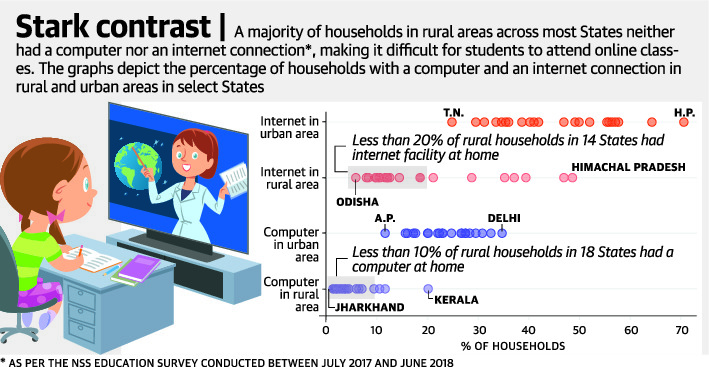Focus: GS-II Social Justice
Context
- For the child in urban Himachal Pradesh, where Internet penetration is higher than 70%, it likely means online schooling, Zoom classes and digital textbooks.
- For the child in rural Odisha, where less than 6% of households have Internet facilities, such options are out of the question.
- Even as digital literacy is likely to grow during this pandemic, concerns remain about basic literacy.
- Over the last decade, literacy rates have increased from 71.7% to 77.7%, with the highest gains coming among rural women.
National Statistical Organisation (NSO) survey reports
- A recent report on the latest National Statistical Organisation (NSO) survey shows just how stark is the digital divide across States, cities and villages, and income groups.
- Across India, only one in ten households have a computer — whether a desktop, laptop or tablet.
- However, almost a quarter of all homes have Internet facilities, accessed via a fixed or mobile network using any device, including smartphones.
- Most of these Internet-enabled homes are located in cities, where 42% have Internet access.
- In rural India, however, only 15% are connected to the internet.
- The biggest divide is by economic status, which the NSO marks by dividing the population into five equal groups, or quintiles, based on their usual monthly per capita expenditure.
How the states fared
- The national capital has the highest Internet access, with 55% of homes having such facilities.
- Himachal Pradesh and Kerala are the only other States where more than half of all households have Internet.
- At the other end of the spectrum is Odisha, where only one in ten homes have Internet.
- There are ten other States with less than 20% Internet penetration, including States with software hubs such as Karnataka and Tamil Nadu.
- Kerala shows the least inequality: more than 39% of the poorest rural homes have Internet, in comparison to 67% of the richest urban homes.
- Assam shows the starkest inequality, with almost 80% of the richest urban homes having the Internet access denied to 94% of those in the poorest rural homes in the State.

Steps taken
- The Centre has directed State Education Departments to map the online access available to all their students in order to adequately plan curriculum and teaching methods that can reach such students.
- Although much of the focus has been on digital platforms, television and radio are also being used to deliver lessons.
-Source: The Hindu





